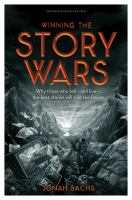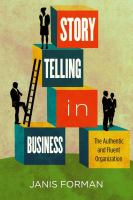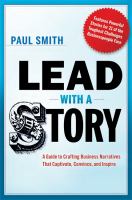Book Reviews: Telling The Story
On May 8, Bloomberg Businessweek reported that two second-year MBA students from Fuqua took first place in a case competition that challenged teams from 70 schools to devise ways of developing diverse workforce talent in science, technology, engineering and math.
Four months earlier, another Fuqua team won the Deloitte National MBA Case Competition. Mark Brown, who leads Fuqua’s Management Communications Center, says that is not unusual. One reason that Fuqua teams win MBA case competitions year after year is because they excel at telling stories – not just the random anecdote, but stories that resonate deeply with people, inspiring listeners to find a particular meaning in events and to share their views. He explains that even in the cold world of business activity, stories still resonate with people, eliciting an emotional response. The story of a corporate merger uses a “boy meets girl” narrative. The story of responding to disruptive technology is equivalent to Stranger in a Strange Land.
At Fuqua, storytelling is taught to first year MBA students soon after they arrive in August. As part of the Global Institute, students learn the art of storytelling in Leadership, Ethics and Organization (LEO) (MANAGEMT 730). This course teaches students how to build successful teams and how to become a leader. It also shows students better ways to communicate, including how to create credible stories. Fuqua students also have an opportunity to hone their skill in the Leadership Communication courses (MGMTCOM 567/568). But the larger business world is also interested in better ways of communicating. In the Ford Library, three new books on storytelling explain how to tell a quality story.
| Winning the story wars by Jonah Sachs. In today’s noisy media marketplace, marketers must cut through the chaos to capture the attention of the audience, and to inspire people to take the message viral. The most successful marketers do this through stories, narratives that influence people’s behavior by reminding them of who are they are and how they should act. Author Jonah Sachs uses mythology, history and psychology to explain how characters in successful stories struggle to reach their potential and to create a better world. He uses dozens of examples from successful and failed campaigns of the past to offer insight and understanding in creating one’s own story. He also provides a simple strategy for crafting a story that is 100 years old: Be interesting. Tell the truth. And if you can’t tell the truth, change what you’re doing so you can. While the focus of the book is on marketing, examples are also from entertainment and politics. |
 |
 |
Storytelling in business : the authentic and fluent organization by Janis Forman. Author Janis Forman is Mark Brown’s counterpart at UCLA. She writes her book for business professionals who want to create succinct and memorable messages to accomplish their goals. She outlines a framework for organizational storytelling and illustrates four cases (Schering-Plough, Chevron, Fed-Ex and Philips) where stories were used to communicate about strategic directions or to build trust in the company/brand. The book ends by explaining how to find and develop a signature story. |
| Lead with a story : a guide to crafting business narratives… by Paul Smith. Paul Smith begins his book with a story about his company, Procter & Gamble, where he is director of Consumer & Communications Research. Illustrating the power of storytelling to teach, his book presents 100 stories that provide insights into solving difficult leadership challenges. These stories can be retold as they are written, or they can serve as a springboard for inspiring the reader’s own stories. He also outlines a structure for crafting a business narrative with emotional appeal. |
 |
© Reviewer: Meg Trauner & Ford Library – Fuqua School of Business.
All rights reserved.